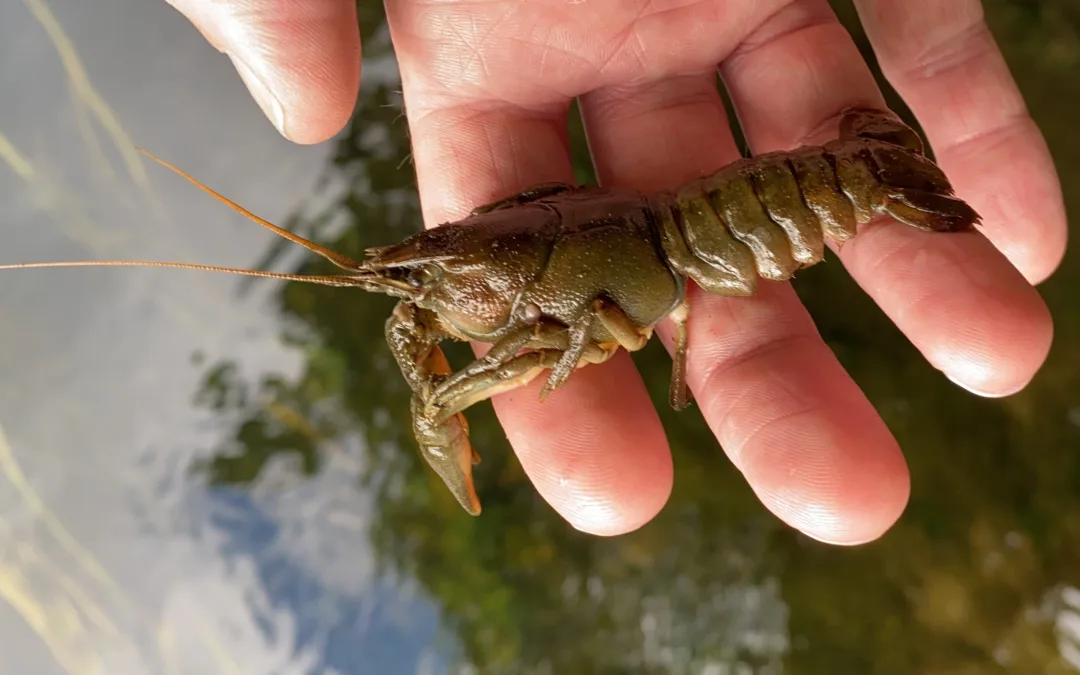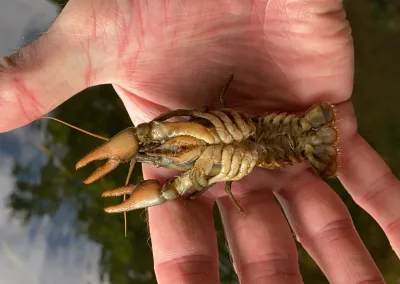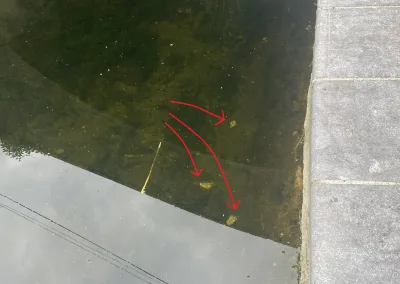White-clawed Crayfish
| See it in: | Most active from late April to August |
| Biodiversity Ireland Species Profile: | White-clawed Crayfish |
White-clawed crayfish are Ireland’s only freshwater crayfish species. Though they’re not from the same family, crayfish look like small lobsters, which makes them easy to identify. Unlike lobsters, of course, white-clawed crayfish only live in freshwater, like our canals, rivers and lakes. The crayfish feed on aquatic invertebrates (insects, snails, etc.) and on vegetation. The crayfish themselves get eaten by eels, pike, etc. when they are small, and they’re also an important part of the diet of otters, which we sometimes see around Ardclough too.
It is still debated as to whether white-clawed crayfish are truly native to Ireland or whether they were introduced, but even if introduced, it was so long ago that they are considered naturalised, rather than invasive. In other words, they are now a settled part of the Irish ecosystem, much like hedgehogs, rabbits and others.
Even though most people here might not notice them or even know that they exist, Ireland is actually an important refuge for white-clawed crayfish. As an island, we are the last country in their native range (west and central Europe) to remain free from non-native crayfish species that could out-compete them, and we were the last country without diseases that significantly affect crayfish.
White-clawed Crayfish in Ireland and Ardclough
Within Ireland, white-clawed crayfish are widespread, but more concentrated in inland counties. The stretch of the Grand Canal that passes through Ardclough, has long been known as a particularly good spot to see them. The crayfish are more active when the water temperature is above 10 degrees, so the most likely time to spot them is in the Summer, from late April, through August. Against they clay substrate of the Grand Canal, their colouring and slow movements make them easy to miss, however, once you know they are there and start to notice them, you could walk along the canal bank on a warm, sunny day, and spot several, moving about, picking delicately with their claws as they forage for food. Or that is, you could, a few years ago…
There may still be crayfish in Ardclough but their population has certainly crashed since about 2020. The photo above is of a dead crayfish found in July 2022 and the last time that I recall spotting a live crayfish in Ardclough was in 2021. Surveys by the Marine Institute have also noticed the population crash. There is no single clear reason for this yet. The most likely suspect would have been crayfish plague, but the surveys didn’t detect it’s presence in Ardclough in 2022.
White-clawed crayfish populations across Europe have been badly impacted by many issues and though the situation is better in Ireland, our populations are following the same patterns. White-clawed crayfish are protected under European and Irish law, requiring areas of conservation and prohibiting catching or any other interference.
Pressures on our crayfish population
There are a lot of factors and potential causes for the collapse in our crayfish population.
Crayfish Plague
Crayfish plague is a fungal disease that has been confirmed in Ireland since about 2015. The disease is endemic in other countries and other species of crayfish, but those other species can survive in balance with the disease. In our white-clawed crayfish, the disease spreads rapidly and wipes out local populations. Crayfish plague has typically arrived in other countries along with other non-native crayfish species – in particular the signal crayfish. There aren’t any records of non-native crayfish in Ireland yet, but the plague is already having a major impact on our Irish white-clawed crayfish populations. The fungus was likely introduced on fishing gear, boats or other equipment that was used in contaminated areas before being brought over and used here.
Poaching
Regular users of the canal bank will have noticed poaching of crayfish – white-clawed crayfish are protected under Irish and EU law and catching crayfish here is illegal. However, since Ardclough has been well known as a good spot for crayfish, we see people attempting to catch them, to eat, every Summer. You can regularly notice chicken drumsticks and other similar meat pieces that have been thrown into the canal as bait and people trying to catch crayfish often seem unconcerned about being noticed, suggesting that either they’re unaware of the conservation status and laws protecting the crayfish, or that they’re unconcerned about getting caught.
The National Parks and Wildlife Service (NPWS) successfully brought two men to prosecution for crayfish poaching, in Ardclough in 2020. It gets a mention in this Irish Times article from May 2024 – Like ‘something from a snuff film’: touring wildlife crime scenes around Dublin with a parks ranger
Habitat disturbance
Mechanical works on the canal banks and dredging, unsurprisingly have an impact on the crayfish. There is some evidence that they can re-establish well, once disturbances have settled down in an area, but continuous works and disturbances will undoubtedly impact their numbers. Apart from the direct impact of burying or destroying the nooks and crannies in which the crayfish are hiding, the settling of silt from upstream works can also be very damaging, as it is for many fish species.
Invasive Species
The crayfish plague itself could be classified as an invasive species, but more obviously, non-native species, such as the signal crayfish have some of the worst impacts on populations. The signal crayfish is native to North America and was introduced to Europe in the 1960s. It is invasive and found in all other countries where white-clawed crayfish are native. It has not yet been recorded in Ireland, but it has a significant risk of arriving.
The signal crayfish can grow larger than the white-clawed crayfish and would potentially outcompete it on that basis alone, however, more significantly, populations of signal crayfish can carry and tolerate crayfish plague. The combination of the plague and invasive signal crayfish would be devastating for white-clawed crayfish in Ireland.
Water Quality
White-clawed crayfish are considered by some to be an indicator species. Because they can be susceptible to issues from poor water quality, their presence suggests that the general ecological health of their habitat and the water quality, is good. The water quality in the Grand Canal in Ardclough appears to be poor at the moment. The large amount of green algae currently present in the canal, suggests a problem with increased nutrients such as nitrates and phosphates. The recent wet weather exacerbates the run off of excess nutrients from fertilisers and slurries, out of our soils and into the water.
Other Pollutants
There are too many possible pollutants to list them all, but there are some others worth considering…
Herbicides – Weed killers, such as glyphosate (e.g. Roundup) despite increasing evidence of their damaging impacts on all manner of wildlife, are still often used in close proximity to the canal bank. Again, recent wet weather will have increased the amount of run-off that gets washed into the canal water.
Flea treatments – This one is really easy to miss, but could be a major problem.
Spot-on flea treatments, used on dogs and other pets are actually a concentrated dose of a general insecticide, typically imidacloprid or fipronil. Imidacloprid for example, is a neonicotinoid, one of the class of insecticides that the EU has recently banned from use in agricultural settings because of how much harm they do to our biodiversity. These insecticides are also water soluble. Research in the UK has shown that there are very high concentrations of these insecticides in rivers and the most likely cause seems to be flea treatments. In Ardclough, we have almost as many dogs who like a walk along the canal, as people. Many of them also like to take a swim, so it’s something important to consider. Contamination from these insecticides, in the water, even at relatively low concentrations, could only be expected to have terrible consequences for crayfish and all aquatic life.
The problem in Ardclough?
We don’t know why the crayfish population in Ardclough has crashed, but it’s worrying. The results from the Marine Institute surveys in 2023 may shed some light once they become available.
It would be nice to identify a single significant cause that we could target and take action against. Unfortunately, even if there is one and we resolve it, all of the issues above and more, are likely still playing a part in the general decline of biodiversity in the Grand Canal in Ardclough.
This Summer, we are of course, hoping to see signs that the crayfish population is bouncing back, with or without the answers. In the meantime though, we’ll do what we can to spread the word and address what issues we can.
What can I do to help?
- Look for crayfish and let us know – if you’re out along the canal this Summer, spend some time looking into the water. If you do see any crayfish, let the local NPWS ranger know about it, or let us know and we’ll pass it on. Photographs are great, and it’s also important to report any sightings of dead crayfish. Reports of the signs of crayfish poaching are useful too, photos of empty packets of chicken pieces, for example. We’ve even seen small lobster pots in the canal.
- Talk about it – let others know about the white-clawed crayfish and about the important role of Ireland and Ardclough in preserving this species. If you spot people trying to catch crayfish, perhaps they’re just unaware of the situation. Let them know.
- Report poaching – if you feel people aren’t open to hearing about the issues or they are more persistent about taking crayfish – or perhaps you don’t feel comfortable engaging them yourself, report it to the local NPWS ranger, or to us and we will pass it on.
- Clean, check, dry – if you are a user of the water – paddle-boarding, canoeing, etc. take appropriate steps to ensure that you don’t spread disease or invasive species from one waterbody to another. Crayfish plague hasn’t been detected in the Grand Canal at Ardclough but it is present in many other water bodies in Ireland. Contaminated equipment can spread this and other diseases or invasive species. Leave no Trace Ireland, has lead a campaign to avoid cross contamination and has good information to help.
- Avoid using pesticides – particularly along water courses, but also generally, herbicides are being discovered to do significantly more harm to our ecosystems than previously believed. Insecticides and rodenticides are obviously harmful and best avoided too.
- Flea treatments – consider using flea treatments only to treat flea infestations. Current advice is to use spot-on treatments at regular intervals to prevent fleas. It means that many, many times more product is sold and used, than would actually be required to control infestations. Unfortunately, it seems that using the treatments as a regular prophylactic has a significant downside for biodiversity. Ensure that any excess treatment products are disposed of safely – don’t wash them into the sin or toilet. Avoid letting your dog into the water, if you are using spot-on treatments.
White-clawed Crayfish
The underside of a dead White-clawed Crayfish found in the canal at Ardclough in July 2022. The claws of our White-clawed Crayfish are pale underneath. The non-native Signal Crayfish’ claws are red underneath.



